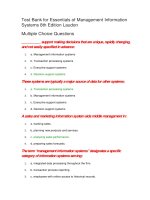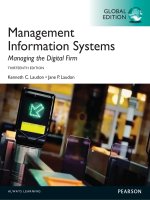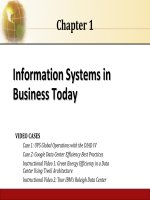Management information systems 13th laudon chapter 08
Bạn đang xem bản rút gọn của tài liệu. Xem và tải ngay bản đầy đủ của tài liệu tại đây (912.62 KB, 51 trang )
Chapter 8
Securing information systems
VIDEO CASES
Case 1: Stuxnet and Cyber Warfare
Case 2: Cyber Espionage: The Chinese Threat
Case 3: UBS Access Key: IBM Zone Trusted Information Channel
Instructional Video 1: Sony PlayStation Hacked; Data Stolen from 77 million users
Instructional Video 2: Zappos Working To Correct Online Security Breach
Instructional Video 3: Meet the Hackers: Anonymous Statement on Hacking SONY
6.1
Copyright © 2014 Pearson Education, Inc.
Management Information Systems
Chapter 8: Securing Information Systems
Learning Objectives
• Explain why information systems are vulnerable to
destruction, error, and abuse.
• Describe the business value of security and control.
• Describe the components of an organizational
framework for security and control.
• Describe the tools and technologies used for
safeguarding information resources.
8.2
Copyright © 2014 Pearson Education, Inc.
Management Information Systems
Chapter 8: Securing Information Systems
You’re on LinkedIn? Watch Out!
• Problem: Massive data breach; using old security
practices
• Solution: Initiative to use minimal up-to-date
industry practices, for example, salting passwords
• Illustrates the need for security practices to keep up
with current standards and threats
• Demonstrates the lack of regulation for corporate
computer security and social network data security;
poor data protection by many companies
8.3
Copyright © 2014 Pearson Education, Inc.
Management Information Systems
Chapter 8: Securing Information Systems
System Vulnerability and Abuse
• Security:
– Policies, procedures, and technical measures used to
prevent unauthorized access, alteration, theft, or
physical damage to information systems
• Controls:
– Methods, policies, and organizational procedures
that ensure safety of organization’s assets; accuracy
and reliability of its accounting records; and
operational adherence to management standards
8.4
Copyright © 2014 Pearson Education, Inc.
Management Information Systems
Chapter 8: Securing Information Systems
System Vulnerability and Abuse
• Why systems are vulnerable
– Accessibility of networks
– Hardware problems (breakdowns, configuration errors,
damage from improper use or crime)
– Software problems (programming errors, installation
errors, unauthorized changes)
– Disasters
– Use of networks/computers outside of firm’s control
– Loss and theft of portable devices
8.5
Copyright © 2014 Pearson Education, Inc.
Management Information Systems
Chapter 8: Securing Information Systems
CONTEMPORARY SECURITY CHALLENGES AND VULNERABILITIES
FIGURE 8-1
8.6
The architecture of a Web-based application typically includes a Web client, a server, and corporate
information systems linked to databases. Each of these components presents security challenges and
vulnerabilities. Floods, fires, power failures, and other electrical problems can cause disruptions at any
point in the network.
Copyright © 2014 Pearson Education, Inc.
Management Information Systems
Chapter 8: Securing Information Systems
System Vulnerability and Abuse
• Internet vulnerabilities
– Network open to anyone
– Size of Internet means abuses can have wide impact
– Use of fixed Internet addresses with cable / DSL
modems creates fixed targets for hackers
– Unencrypted VOIP
– E-mail, P2P, IM
• Interception
• Attachments with malicious software
• Transmitting trade secrets
8.7
Copyright © 2014 Pearson Education, Inc.
Management Information Systems
Chapter 8: Securing Information Systems
System Vulnerability and Abuse
• Wireless security challenges
– Radio frequency bands easy to scan
– SSIDs (service set identifiers)
• Identify access points
• Broadcast multiple times
• Can be identified by sniffer programs
• War driving
– Eavesdroppers drive by buildings and try to detect SSID and gain
access to network and resources
• Once access point is breached, intruder can use OS to
access networked drives and files
8.8
Copyright © 2014 Pearson Education, Inc.
Management Information Systems
Chapter 8: Securing Information Systems
WI-FI SECURITY CHALLENGES
Many Wi-Fi networks can be
penetrated easily by intruders
using sniffer programs to
obtain an address to access
the resources of a network
without authorization.
FIGURE 8-2
8.9
Copyright © 2014 Pearson Education, Inc.
Management Information Systems
Chapter 8: Securing Information Systems
System Vulnerability and Abuse
• Malware (malicious software)
– Viruses
• Rogue software program that attaches itself to other
software programs or data files in order to be executed
– Worms
• Independent programs that copy themselves from one
computer to other computers over a network.
– Worms and viruses spread by
• Downloads (drive-by downloads)
• E-mail, IM attachments
• Downloads on Web sites and social networks
8.10
Copyright © 2014 Pearson Education, Inc.
Management Information Systems
Chapter 8: Securing Information Systems
System Vulnerability and Abuse
• Malware (cont.)
– Smartphones as vulnerable as computers
• Study finds 13,000 types of smartphone malware
– Trojan horses
• Software that appears benign but does something
other than expected
– SQL injection attacks
• Hackers submit data to Web forms that exploits site’s
unprotected software and sends rogue SQL query to
database
8.11
Copyright © 2014 Pearson Education, Inc.
Management Information Systems
Chapter 8: Securing Information Systems
System Vulnerability and Abuse
• Malware (cont.)
– Spyware
• Small programs install themselves surreptitiously on
computers to monitor user Web surfing activity and
serve up advertising
• Key loggers
– Record every keystroke on computer to steal serial numbers,
passwords, launch Internet attacks
• Other types:
– Reset browser home page
– Redirect search requests
– Slow computer performance by taking up memory
8.12
Copyright © 2014 Pearson Education, Inc.
Management Information Systems
Chapter 8: Securing Information Systems
System Vulnerability and Abuse
• Hackers and computer crime
– Hackers vs. crackers
– Activities include:
• System intrusion
• System damage
• Cybervandalism
– Intentional disruption, defacement, destruction
of Web site or corporate information system
8.13
Copyright © 2014 Pearson Education, Inc.
Management Information Systems
Chapter 8: Securing Information Systems
System Vulnerability and Abuse
• Spoofing
– Misrepresenting oneself by using fake e-mail
addresses or masquerading as someone else
– Redirecting Web link to address different from
intended one, with site masquerading as intended
destination
• Sniffer
– Eavesdropping program that monitors information
traveling over network
– Enables hackers to steal proprietary information such
as e-mail, company files, and so on
8.14
Copyright © 2014 Pearson Education, Inc.
Management Information Systems
Chapter 8: Securing Information Systems
System Vulnerability and Abuse
• Denial-of-service attacks (DoS)
– Flooding server with thousands of false requests to
crash the network
• Distributed denial-of-service attacks (DDoS)
– Use of numerous computers to launch a DoS
– Botnets
• Networks of “zombie” PCs infiltrated by bot malware
• Deliver 90% of world spam, 80% of world malware
• Grum botnet: controlled 560K to 840K computers
8.15
Copyright © 2014 Pearson Education, Inc.
Management Information Systems
Chapter 8: Securing Information Systems
System Vulnerability and Abuse
• Computer crime
– Defined as “any violations of criminal law that involve
a knowledge of computer technology for their
perpetration, investigation, or prosecution”
– Computer may be target of crime, for example:
• Breaching confidentiality of protected computerized data
• Accessing a computer system without authority
– Computer may be instrument of crime, for example:
• Theft of trade secrets
• Using e-mail for threats or harassment
8.16
Copyright © 2014 Pearson Education, Inc.
Management Information Systems
Chapter 8: Securing Information Systems
System Vulnerability and Abuse
• Identity theft
– Theft of personal Information (social security ID,
driver’s license, or credit card numbers) to impersonate
someone else
• Phishing
– Setting up fake Web sites or sending e-mail messages
that look like legitimate businesses to ask users for
confidential personal data.
• Evil twins
– Wireless networks that pretend to offer trustworthy
Wi-Fi connections to the Internet
8.17
Copyright © 2014 Pearson Education, Inc.
Management Information Systems
Chapter 8: Securing Information Systems
System Vulnerability and Abuse
• Pharming
– Redirects users to a bogus Web page, even when
individual types correct Web page address into his or
her browser
• Click fraud
– Occurs when individual or computer program
fraudulently clicks on online ad without any
intention of learning more about the advertiser or
making a purchase
• Cyberterrorism and Cyberwarfare
8.18
Copyright © 2014 Pearson Education, Inc.
Management Information Systems
Chapter 8: Securing Information Systems
Interactive Session: Organizations
Stuxnet and the Changing Face of Cyberwarfare
Read the Interactive Session and discuss the following questions
• Is cyberwarfare a serious problem? Why or why not?
• Assess the management, organization, and technology factors
that have created this problem.
• What makes Stuxnet different from other cyberwarfare
attacks? How serious a threat is this technology?
• What solutions have been proposed for this problem? Do you
think they will be effective? Why or why not?
8.19
Copyright © 2014 Pearson Education, Inc.
Management Information Systems
Chapter 8: Securing Information Systems
System Vulnerability and Abuse
• Internal threats: Employees
– Security threats often originate inside an
organization
– Inside knowledge
– Sloppy security procedures
• User lack of knowledge
– Social engineering:
• Tricking employees into revealing their passwords by
pretending to be legitimate members of the company
in need of information
8.20
Copyright © 2014 Pearson Education, Inc.
Management Information Systems
Chapter 8: Securing Information Systems
System Vulnerability and Abuse
• Software vulnerability
– Commercial software contains flaws that create
security vulnerabilities
• Hidden bugs (program code defects)
– Zero defects cannot be achieved because complete testing is
not possible with large programs
• Flaws can open networks to intruders
– Patches
• Small pieces of software to repair flaws
• Exploits often created faster than patches can be
released and implemented
8.21
Copyright © 2014 Pearson Education, Inc.
Management Information Systems
Chapter 8: Securing Information Systems
Business Value of Security and Control
• Failed computer systems can lead to significant or total
loss of business function.
• Firms now are more vulnerable than ever.
– Confidential personal and financial data
– Trade secrets, new products, strategies
• A security breach may cut into a firm’s market value
almost immediately.
• Inadequate security and controls also bring forth issues
of liability.
8.22
Copyright © 2014 Pearson Education, Inc.
Management Information Systems
Chapter 8: Securing Information Systems
Business Value of Security and Control
• Legal and regulatory requirements for electronic records management and
privacy protection
– HIPAA: Medical security and privacy rules and procedures
– Gramm-Leach-Bliley Act: Requires financial institutions to
ensure the security and confidentiality of customer data
– Sarbanes-Oxley Act: Imposes responsibility on companies
and their management to safeguard the accuracy and
integrity of financial information that is used internally and
released externally
8.23
Copyright © 2014 Pearson Education, Inc.
Management Information Systems
Chapter 8: Securing Information Systems
Business Value of Security and Control
• Electronic evidence
– Evidence for white collar crimes often in digital form
• Data on computers, e-mail, instant messages,
commerce transactions
e-
– Proper control of data can save time and money when
responding to legal discovery request
• Computer forensics:
– Scientific collection, examination, authentication,
preservation, and analysis of data from computer
storage media for use as evidence in court of law
– Includes recovery of ambient and hidden data
8.24
Copyright © 2014 Pearson Education, Inc.
Management Information Systems
Chapter 8: Securing Information Systems
Establishing a Framework for Security and Control
• Information systems controls
– Manual and automated controls
– General and application controls
• General controls
– Govern design, security, and use of computer
programs and security of data files in general
throughout organization’s information technology
infrastructure
– Apply to all computerized applications
– Combination of hardware, software, and manual
procedures to create overall control environment
8.25
Copyright © 2014 Pearson Education, Inc.









